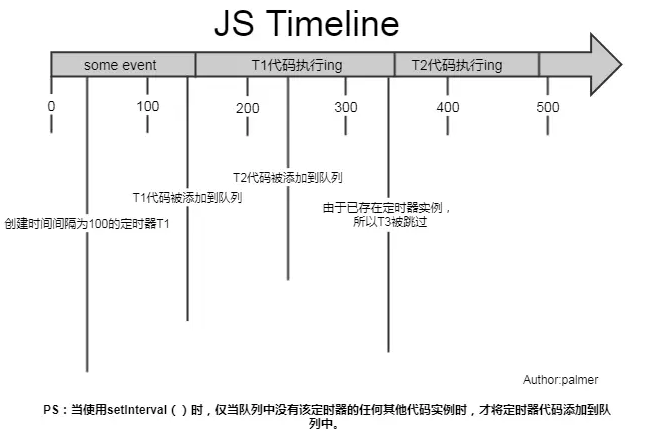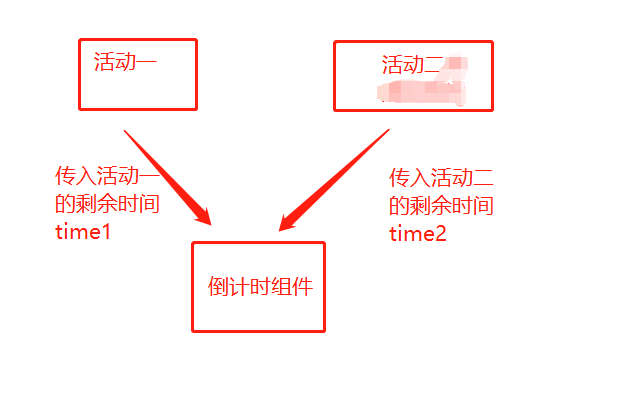一、前言
入职的第一个需求是跟着一位前端大佬一起完成的一个活动项目。
由于是一起开发,喜欢阅读源码的我,当然不会放过阅读大佬的代码的机会。
因为我的页面中需要使用到倒计时功能,发现大佬的已经写了个现成的倒计时组件,于是直接就拿过来用了。
传个参数就实现了功能的感觉真是太棒了。项目完成后,就膜拜了一下大佬的倒计时组件的代码。真是让我学到了不少。列举如下:
- 计时器为什么要用setTimeout而不用setInterval
- 为什么不直接将剩余时间-1。
- 如何将所需要的时间返回出去(有可能我只需要分钟和秒数,那就只返回分钟和秒数,也有可能我全都要)。
- 不确定接口返回的是剩余时间还是截止日期,该怎么同时兼容这两种情况。
- 不确定接口返回的时间是秒还是毫秒单位。
好了,你可能不太理解这些问题,但是没关系,看完下面的解释,相信你会豁然开朗。
二、开始手操
1. 先创建一个vue组件
- <template>
- <div class="_base-count-down">
- </div>
- </template>
- <script>
- export default {
- data: () => ({
- }),
- props: {
- },
- };
- </script>
- <style lang='scss' scoped>
- </style>
2. 实现基本的倒计时组件
接下来,假设接口获得的是一个剩余时间。
将剩余时间time传入这个倒计时组件,由于time可能是秒为单位的,也有可能是毫秒为单位的,所以我们需要在传入time的是有也传入一个isMilliSecond来告诉倒计时组件这个time是毫秒还是秒为单位的。如下代码中的props所示。
- <template>
- <div class="_base-count-down">
- </div>
- </template>
- <script>
- export default {
- data: () => ({
- }),
- props: {
- time: {
- type: [Number, String],
- default: 0
- },
- isMilliSecond: {
- type: Boolean,
- default: false
- }
- },
- computed: {
- duration() {
- const time = this.isMiniSecond ? Math.round(+this.time / 1000) : Math.round(+this.time);
- return time;
- }
- },
- };
- </script>
- <style lang='scss' scoped>
- </style>
computed中的duration是将time进行转化的结果,不管time是毫秒还是秒,都转化为秒 不知道你注意到了没有:+this.time。为什么要在前面加个‘+’号。这点很值得我们学习,因为接口返回的一串数字有时候是字符串的形式,有时候是数字的形式(不能过分相信后端同学,必须自己做好防范)。所以通过前面加个‘+’号 通通转化为数字。现在的duration就是转化后的time啦!
我们获得duration之后就可以开始倒计时了
- <template>
- <div class="_base-count-down">
- </div>
- </template>
- <script>
- export default {
- data: () => ({
- }),
- props: {
- time: {
- type: [Number, String],
- default: 0
- },
- isMilliSecond: {
- type: Boolean,
- default: false
- }
- },
- computed: {
- duration() {
- const time = this.isMiniSecond ? Math.round(+this.time / 1000) : Math.round(+this.time);
- return time;
- }
- },
- // 新增代码:
- mounted() {
- this.countDown();
- },
- methods: {
- countDown() {
- this.getTime(this.duration);
- },
- }
- };
- </script>
- <style lang='scss' scoped>
- </style>
在这里创建了一个countDown方法,表示开始倒计时的意思,已进入页面就开始执行countdown方法。
countDown方法调用了getTime方法,getTime需要传入duration这个参数,也就是我们获得的剩余时间。
现在来实现一下这个方法。
- <template>
- <div class="_base-count-down">
- 还剩{{day}}天{{hours}}:{{mins}}:{{seconds}}
- </div>
- </template>
- <script>
- export default {
- data: () => ({
- days: '0',
- hours: '00',
- mins: '00',
- seconds: '00',
- timer: null,
- }),
- props: {
- time: {
- type: [Number, String],
- default: 0
- },
- isMilliSecond: {
- type: Boolean,
- default: false
- }
- },
- computed: {
- duration() {
- const time = this.isMiniSecond ? Math.round(+this.time / 1000) : Math.round(+this.time);
- return time;
- }
- },
- mounted() {
- this.countDown();
- },
- methods: {
- countDown() {
- this.getTime(this.duration);
- },
- // 新增代码:
- getTime(duration) {
- this.timer && clearTimeout(this.timer);
- if (duration < 0) {
- return;
- }
- const { dd, hh, mm, ss } = this.durationFormatter(duration);
- this.days = dd || 0;
- this.hours = hh || 0;
- this.mins = mm || 0;
- this.seconds = ss || 0;
- this.timer = setTimeout(() => {
- this.getTime(duration - 1);
- }, 1000);
- }
- }
- };
- </script>
- <style lang='scss' scoped>
- </style>
可以看到,getTime的目的就是获得 days,hours,mins,seconds,然后显示到html上,并且通过定时器实时来刷新days,hours,mins,seconds这个几个值。从而实现了倒计时。很简单,有木有?
durationFormatter是一个将duration转化成天数,小时,分钟,秒数的方法,很简单,可以看下它的具体实现。
- durationFormatter(time) {
- if (!time) return { ss: 0 };
- let t = time;
- const ss = t % 60;
- t = (t - ss) / 60;
- if (t < 1) return { ss };
- const mm = t % 60;
- t = (t - mm) / 60;
- if (t < 1) return { mm, ss };
- const hh = t % 24;
- t = (t - hh) / 24;
- if (t < 1) return { hh, mm, ss };
- const dd = t;
- return { dd, hh, mm, ss };
- },
好了,问题开始来了!!
3. 为什么要用setTimeout来模拟setInterval的行为?
这里用setInerval不是更方便吗?
- setTimeout(function(){··· }, n); // n毫秒后执行function
- setInterval(function(){··· }, n); // 每隔n毫秒执行一次function
可以看看setInterval有什么缺点:
再次强调,定时器指定的时间间隔,表示的是何时将定时器的代码添加到消息队列,而不是何时执行代码。所以真正何时执行代码的时间是不能保证的,取决于何时被主线程的事件循环取到,并执行。
- setInterval(function, N)
- //即:每隔N秒把function事件推到消息队列中

上图可见,setInterval每隔100ms往队列中添加一个事件;100ms后,添加T1定时器代码至队列中,主线程中还有任务在执行,所以等待,some event执行结束后执行T1定时器代码;又过了100ms,T2定时器被添加到队列中,主线程还在执行T1代码,所以等待;又过了100ms,理论上又要往队列里推一个定时器代码,但由于此时T2还在队列中,所以T3不会被添加,结果就是此时被跳过;这里我们可以看到,T1定时器执行结束后马上执行了T2代码,所以并没有达到定时器的效果。
综上所述,setInterval有两个缺点:
- 使用setInterval时,某些间隔会被跳过;
- 可能多个定时器会连续执行;
可以这么理解:每个setTimeout产生的任务会直接push到任务队列中;而setInterval在每次把任务push到任务队列前,都要进行一下判断(看上次的任务是否仍在队列中)。
因而我们一般用setTimeout模拟setInterval,来规避掉上面的缺点。
4. 为什么要clearTimeout(this.timer)
第二问:为什么要有this.timer && clearTimeout(this.timer);这一句?
假设一个场景:
如图所示,在倒计时的父组件中,有两个按钮,点击活动一就会传入活动一的剩余时间,点击活动二,就会传入活动二的时间。

如果此时倒计时组件正在做活动一的倒计时,然后点击活动二,就要会马上传入新的time,这个时候就需要重新计时。当然,这里并不会重新计时,因为组件的mounted只会执行一次。也就是说this.countDown();只会执行一次,也就是说this.getTime(this.duration);只会执行一次,因此duration还是活动一的时间,怎么办呢?watch派上用场了。
我们来监听duration,如果发现duration变化,说明新的时间time传入组件,这时就要重新调用this.countDown()。
代码如下:
- <template>
- <div class="_base-count-down">
- 还剩{{day}}天{{hours}}:{{mins}}:{{seconds}}
- </div>
- </template>
- <script>
- export default {
- data: () => ({
- days: '0',
- hours: '00',
- mins: '00',
- seconds: '00',
- timer: null,
- }),
- props: {
- time: {
- type: [Number, String],
- default: 0
- },
- isMilliSecond: {
- type: Boolean,
- default: false
- }
- },
- computed: {
- duration() {
- const time = this.isMiniSecond ? Math.round(+this.time / 1000) : Math.round(+this.time);
- return time;
- }
- },
- mounted() {
- this.countDown();
- },
- // 新增代码:
- watch: {
- duration() {
- this.countDown();
- }
- },
- methods: {
- countDown() {
- this.getTime(this.duration);
- },
- durationFormatter(){...}
- getTime(duration) {
- this.timer && clearTimeout(this.timer);
- if (duration < 0) {
- return;
- }
- const { dd, hh, mm, ss } = this.durationFormatter(duration);
- this.days = dd || 0;
- this.hours = hh || 0;
- this.mins = mm || 0;
- this.seconds = ss || 0;
- this.timer = setTimeout(() => {
- this.getTime(duration - 1);
- }, 1000);
- }
- }
- };
- </script>
- <style lang='scss' scoped>
- </style>
好了,但是并没有解释上面提出的那个问题:为什么要有this.timer && clearTimeout(this.timer);这一句?
这样,假设现在页面显示的是活动一的时间,这时,执行到setTimeout,在一秒后就会把setTimeout里的回调函数放到任务队列中,注意是一秒后哦!这时,然而,在这一秒的开头,我们点击了活动二按钮,这时候的活动二的时间就会传入倒计时组件中,然后触发countDown(),也就调用this.getTime(this.duration);,然后执行到setTimeout,也会一秒后把回调函数放到任务队列中。
这时,任务队列中就会有两个setTimeout的回调函数了。等待一秒过去,两个回调函数相继执行,我们就会看到页面上的时间一下子背减了2,实际上是很快速地进行了两遍减1的操作。
这就是为什么要添加上this.timer && clearTimeout(this.timer);这一句的原因了。就是要把上一个setTimeout清除掉。
5. 使用 diffTime
当你认为这是一个完美的组件的时候,你想把这个组件用到项目上,假设你也确实用了,而且还上线了,确发现出现了个大问题:当页面打开的时候,倒计时开始了,时间是 还剩1天12:25:25,然后有人给你发微信,你马上切换到微信,回复消息后切回浏览器,发现倒计时时间却还是还剩1天12:25:25。你慌了:你写的代码出现bug了!
这是怎么回事?
出于节能的考虑, 部分浏览器在进入后台时(或者失去焦点时), 会将 setTimeout 等定时任务暂停 待用户回到浏览器时, 才会重新激活定时任务
说是暂停, 其实应该说是延迟, 1s 的任务延迟到 2s, 2s 的延迟到 5s, 实际情况因浏览器而异。
原来如此,看来不能每次都只是减1这么简单了(毕竟你把浏览器切到后台之后setTimeout就冷却了,等几秒后切回,然后执行setTimeout,只是减了一秒而已)。
所以我们需要改写一下getTime方法。
- <template>
- <div class="_base-count-down">
- 还剩{{day}}天{{hours}}:{{mins}}:{{seconds}}
- </div>
- </template>
- <script>
- export default {
- data: () => ({
- days: '0',
- hours: '00',
- mins: '00',
- seconds: '00',
- timer: null,
- curTime: 0,// 新增代码:
- }),
- props: {
- time: {
- type: [Number, String],
- default: 0
- },
- isMilliSecond: {
- type: Boolean,
- default: false
- }
- },
- computed: {
- duration() {
- const time = this.isMiniSecond ? Math.round(+this.time / 1000) : Math.round(+this.time);
- return time;
- }
- },
- mounted() {
- this.countDown();
- },
- watch: {
- duration() {
- this.countDown();
- }
- },
- methods: {
- countDown() {
- // 新增代码:
- this.curTime = Date.now();
- this.getTime(this.duration);
- },
- durationFormatter(){...}
- getTime(duration) {
- this.timer && clearTimeout(this.timer);
- if (duration < 0) {
- return;
- }
- const { dd, hh, mm, ss } = this.durationFormatter(duration);
- this.days = dd || 0;
- this.hours = hh || 0;
- this.mins = mm || 0;
- this.seconds = ss || 0;
- this.timer = setTimeout(() => {
- // 新增代码:
- const now = Date.now();
- const diffTime = Math.floor((now - this.curTime) / 1000);
- this.curTime = now;
- this.getTime(duration - diffTime);
- }, 1000);
- }
- }
- };
- </script>
- <style lang='scss' scoped>
- </style>
可以看到,我们在三个位置添加了新的代码。
首先在data了添加了curTime这个变量,然后在执行countDown的时候给curTime赋值Date.now(),也就是当前的时刻,也就是显示在页面上的那个时刻。
然后看修改的第三处代码。可以看到是将-1改成了-diffTime。
now 是 setTimeout的回调函数执行的时候的那个时刻。
因而 diffTime 则 表示 当前这个setTimeout的回调函数执行的时刻距离上 页面上的剩余时间上一次变化的时间段。其实也就是 当前这个setTimeout的回调函数执行的时刻距离上 一个setTimeout的回调函数执行的时刻时间段。
可能你还是不太能理解diffTime。举个例子:
你打开了这个倒计时页面,于是执行了countDown,也就是说要执行getTime这个方法了。也就是会马上执行下列的代码。
- this.days = dd || 0;
- this.hours = hh || 0;
- this.mins = mm || 0;
- this.seconds = ss || 0;
执行完这些代码页面上就会出现剩余时间。
而this.curTime = Date.now(); 就记录下了此刻的时间点。
然后一秒后执行setTimeout里的回调函数:
const now = Date.now(); 记录当前这个setTimeout的回调函数执行的时间点。
const diffTime = Math.floor((now - this.curTime) / 1000); 记录当前这个setTimeout的回调函数执行的时间点距离页面上开始 渲染 剩余时间的 这一段时间。其实此时的diffTime就是=1。
然后this.curTime = now; 将curTime的值变成当前这个setTimeout的回调函数执行的时间点。
this.getTime(duration - diffTime); 其实就是this.getTime(duration - 1);
然后又执行getTime,就会重新执行下面的代码,有渲染了新的剩余时间。
- this.days = dd || 0;
- this.hours = hh || 0;
- this.mins = mm || 0;
- this.seconds = ss || 0;
然后一秒后又要执行setTmieout的回调函数,在这一秒还没结束的时候,我们将浏览器切到后台,此时setTimeout冷却了。等5秒后再切回。于是setTmieout的回调函数才得以执行。
这时const now = Date.now(); 记录当前这个setTimeout的回调函数执行的时间点。
而curTime是上一个setTimeout的回调函数执行的时间。
所以const diffTime = Math.floor((now - this.curTime) / 1000);实际上,diffTime的值就是5秒。
因而this.getTime(duration - diffTime); 其实就是this.getTime(duration - 5);
这样就完美解决了因为浏览器切到后台,导致剩余时间不变的问题。
6. 添加新功能:可以传入到期时间。
之前是只能传入剩余时间的,现在希望也支持传入到期时间。
只需要改动一下duration就好了。
- computed: {
- duration() {
- if (this.end) {
- let end = String(this.end).length >= 13 ? +this.end : +this.end * 1000;
- end -= Date.now();
- return end;
- }
- const time = this.isMiniSecond ? Math.round(+this.time / 1000) : Math.round(+this.time);
- return time;
- }
- },
判断传入的end的长度是否大于13来判断是秒还是毫秒。轻松!
7. 添加新功能:可以选择要显示的内容,例如只显示秒,或者只显示小时。
只需要改动一下html:
- <template>
- <div class="_base-count-down no-rtl">
- <div class="content">
- <slot v-bind="{
- d: days, h: hours, m: mins, s: seconds,
- hh: `00${hours}`.slice(-2),
- mm: `00${mins}`.slice(-2),
- ss: `00${seconds}`.slice(-2),
- }"></slot>
- </div>
- </div>
- </template>
很巧妙有没有,只需要用插槽,就把倒计时组件,也就是把子组件的值传递给父组件了。
看看父组件是怎么使用这个组件的。
- <base-counter v-slot="timeObj" :time="countDown">
- <div class="count-down">
- <div class="icon"></div>
- {{timeObj.d}}天{{timeObj.hh}}小时{{timeObj.mm}}分钟{{timeObj.ss}}秒
- </div>
- </base-counter>
看,如此巧妙又简单。
发现00${hours}.slice(-2) 这种写法也很值得学习。以前在获得到分钟的时候,要手动判断获得的分钟是两位数还是一位数,如果是一位数的话就要在前面手动补上0。就像下面的代码:
- var StartMinute = startDate.getMinutes().toString().length >= 2 ? startDate.getMinutes() : '0' + startDate.getHours();
而00${hours}.slice(-2) 则不用判断,先补上0再说,然后再从后面往前截取两位。
到此。
一个完美的倒计时组件就完成了。
三、学习总结
- 明白了setInterval的缺点以及用setTimeout代替setInterval。
- 学到了“+”,操作,不管三七二十一,将接口得到的长串数字转化为数字保平安。
- 利用clearTimeout来清除掉之前的计时器,以防止造成影响。
- 学会使用v-slot来子传父传值
- 学会一个倒计时组件,为了以后方便cv操作。把组件完整代码贴上:
- <template>
- <div class="_base-count-down no-rtl">
- <div class="content">
- <slot v-bind="{
- d: days, h: hours, m: mins, s: seconds,
- hh: `00${hours}`.slice(-2),
- mm: `00${mins}`.slice(-2),
- ss: `00${seconds}`.slice(-2),
- }"></slot>
- </div>
- </div>
- </template>
- <script>
- /* eslint-disable object-curly-newline */
- export default {
- data: () => ({
- days: '0',
- hours: '00',
- mins: '00',
- seconds: '00',
- timer: null,
- curTime: 0
- }),
- props: {
- time: {
- type: [Number, String],
- default: 0
- },
- refreshCounter: {
- type: [Number, String],
- default: 0
- },
- end: {
- type: [Number, String],
- default: 0
- },
- isMiniSecond: {
- type: Boolean,
- default: false
- }
- },
- computed: {
- duration() {
- if (this.end) {
- let end = String(this.end).length >= 13 ? +this.end : +this.end * 1000;
- end -= Date.now();
- return end;
- }
- const time = this.isMiniSecond ? Math.round(+this.time / 1000) : Math.round(+this.time);
- return time;
- }
- },
- mounted() {
- this.countDown();
- },
- watch: {
- duration() {
- this.countDown();
- },
- refreshCounter() {
- this.countDown();
- }
- },
- methods: {
- durationFormatter(time) {
- if (!time) return { ss: 0 };
- let t = time;
- const ss = t % 60;
- t = (t - ss) / 60;
- if (t < 1) return { ss };
- const mm = t % 60;
- t = (t - mm) / 60;
- if (t < 1) return { mm, ss };
- const hh = t % 24;
- t = (t - hh) / 24;
- if (t < 1) return { hh, mm, ss };
- const dd = t;
- return { dd, hh, mm, ss };
- },
- countDown() {
- // eslint-disable-next-line no-unused-expressions
- this.curTime = Date.now();
- this.getTime(this.duration);
- },
- getTime(time) {
- // eslint-disable-next-line no-unused-expressions
- this.timer && clearTimeout(this.timer);
- if (time < 0) {
- return;
- }
- // eslint-disable-next-line object-curly-newline
- const { dd, hh, mm, ss } = this.durationFormatter(time);
- this.days = dd || 0;
- // this.hours = `00${hh || ''}`.slice(-2);
- // this.mins = `00${mm || ''}`.slice(-2);
- // this.seconds = `00${ss || ''}`.slice(-2);
- this.hours = hh || 0;
- this.mins = mm || 0;
- this.seconds = ss || 0;
- this.timer = setTimeout(() => {
- const now = Date.now();
- const diffTime = Math.floor((now - this.curTime) / 1000);
- const step = diffTime > 1 ? diffTime : 1; // 页面退到后台的时候不会计时,对比时间差,大于1s的重置倒计时
- this.curTime = now;
- this.getTime(time - step);
- }, 1000);
- }
- }
- };
- </script>
- <style lang='scss' scoped>
- @import '~@assets/css/common.scss';
- ._base-count-down {
- color: #fff;
- text-align: left;
- position: relative;
- .content {
- width: auto;
- display: flex;
- align-items: center;
- }
- span {
- display: inline-block;
- }
- .section {
- position: relative;
- }
- }
- </style>
































